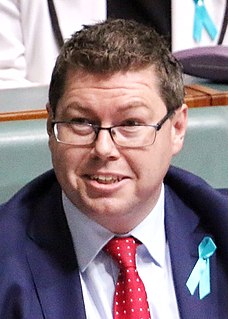Related Research Articles

The Royal Australian Navy (RAN) is the principal naval force of Australia, a part of the Australian Defence Force (ADF) along with the Australian Army and Royal Australian Air Force. The Navy is commanded by the Chief of Navy (CN), who is subordinate to the Chief of the Defence Force (CDF) who commands the ADF; the current CN is Vice Admiral Mark Hammond. The CN is also directly responsible to the Minister of Defence, with the Department of Defence administering the ADF and the Navy.
Department of Defence or Department of Defense may refer to:

The Australian Defence Force (ADF) is the military organisation responsible for the defence of the Commonwealth of Australia and its national interests. It consists of the Royal Australian Navy (RAN), Australian Army, Royal Australian Air Force (RAAF) and several "tri-service" units. The ADF has a strength of just over 85,000 full-time personnel and active reservists and is supported by the Department of Defence and several other civilian agencies.

Defence Intelligence (DI) is an organisation within the United Kingdom intelligence community which focuses on gathering and analysing military intelligence. It differs from the UK's intelligence agencies in that it is an integral part of a government department – the Ministry of Defence (MoD) – rather than a stand-alone organisation. The organisation employs a mixture of civilian and military staff and is funded within the UK's defence budget. The organisation was formerly known as the Defence Intelligence Staff (DIS), but changed its name in 2009.

The Treasurer of Australia is a high ranking official and senior minister of the Crown in the Government of Australia who is the head of the Ministry of the Treasury which is responsible for government expenditure and for collecting revenue. The Treasurer plays a key role in the economic policy of the government. The current Australian Treasurer is Jim Chalmers whose term began on 23 May 2022.

The Minister for Defence is the principal minister responsible for the organisation, implementation, and formulation of government policy in defence and military matters for the Australian Government. The individual who holds this office directs the government’s approach to such matters through the Australian Defence Organisation and, by extension, the Department of Defence and the Australian Defence Force. The office of the Minister for Defence, like all Cabinet positions, is not referenced in the Constitution of Australia but rather exists through convention and the right of the Governor-General to appoint ministers of state.
The Australian Geospatial-Intelligence Organisation (AGO) is an Australian government intelligence agency that is part of the Department of Defence responsible for the collection, analysis, and distribution of geospatial intelligence (GEOINT) in support of Australia's defence and national interests. The AGO is one of six agencies that form the Australian Intelligence Community.
The Australian Intelligence Community (AIC) and the National Intelligence Community (NIC) or National Security Community of the Australian Government are the collectives of statutory intelligence agencies, policy departments, and other government agencies concerned with protecting and advancing the national security and national interests of the Commonwealth of Australia. The intelligence and security agencies of the Australian Government have evolved since the Second World War and the Cold War and saw transformation and expansion during the Global War on Terrorism with military deployments in Afghanistan, Iraq and against ISIS in Syria. Key international and national security issues for the Australian Intelligence Community include terrorism and violent extremism, cybersecurity, transnational crime, the rise of China, and Pacific regional security.

The Attorney-General's Department is a department of the federal government of Australia responsible for law and justice, and since 29 May 2019, industrial relations.
Defence Australia is a department of the Government of Australia charged with the responsibility to defend Australia and its national interests. Along with the Australian Defence Force (ADF), it forms part of the Australian Defence Organisation (ADO) and is accountable to the Commonwealth Parliament, on behalf of the Australian people, for the efficiency and effectiveness with which it carries out the Government's defence policy.

The Ministry of Defence (MoD) is charged with coordinating and supervising all agencies and functions of the government relating directly to national security and the Indian Armed Forces. The President of India is the ceremonial commander-in-chief of the armed forces of the country. The Ministry of Defence provides policy framework and resources to the armed forces to discharge their responsibility in the context of the defence of the country. The Indian Armed Forces and Indian Coast Guard under the Ministry of Defence are primarily responsible for ensuring the territorial integrity of India.

The Australian Strategic Policy Institute (ASPI) is a defence and strategic policy think tank based in Canberra, Australian Capital Territory, founded by the Australian government and funded by the Australian and overseas governments, industry and civil society groups.

Women currently make up 19.2% of the ADF workforce. Women have served in Australian armed forces since 1899. Until World War II women were restricted to the Australian Army Nursing Service. This role expanded in 1941–42 when the Royal Australian Navy (RAN), Australian Army and Royal Australian Air Force established female branches in which women took on a range of support roles. While these organisations were disbanded at the end of the war, they were reestablished in 1950 as part of the military's permanent structure. Women were integrated into the services during the late 1970s and early 1980s, but were not allowed to apply for combat roles. In January 2013, serving women were allowed to apply for all positions in the Australian Defence Force (ADF) except special forces which became open to women in January 2014. In January 2016, civilian women became able to direct entry to all positions.

In the Government of Australia, the Minister for Defence Industry is currently the Hon. Pat Conroy MP since 1 June 2022, following the Australian federal election in 2022.

The RAAF Woomera Range Complex (WRC) is a major Australian military and civil aerospace facility and operation located in South Australia, approximately 450 km (280 mi) north-west of Adelaide. The WRC is operated by the Royal Australian Air Force (RAAF), a division of the Australian Defence Force (ADF). The complex has a land area of 122,188 km2 (47,177 sq mi) or roughly the size of North Korea or Pennsylvania. The airspace above the area is restricted and controlled by the RAAF for safety and security. The WRC is a highly specialised ADF test and evaluation capability operated by the RAAF for the purposes of testing defence materiel.
The Department of Industry, Technology and Commerce was an Australian government department that existed between December 1984 and March 1993.
The Department of Industry, Science and Resources was an Australian government department that existed between October 1998 and November 2001.
The Department of Supply and Development was an Australian government department that existed between April 1948 and March 1950.
The Department of Supply and Development was an Australian government department that existed between April 1939 and October 1942.
The Department of Munitions was an Australian government department that existed between 11 June 1940 and April 1948. Reporting to it was the Factory Board, which was in charge of the six Small Arms Ammunition Factories, along with a number of ammunition and explosives factories across Australia. The Minister for Munitions was responsible for the Department.
References
- 1 2 3 4 CA 58: Department of Defence Production, Central Administration, National Archives of Australia, retrieved 28 September 2014